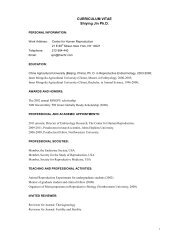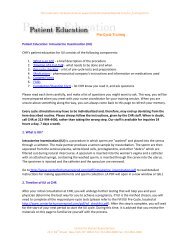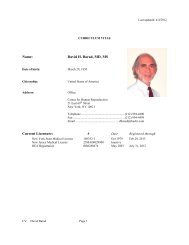View Dr. Wu's CV - Center for Human Reproduction
View Dr. Wu's CV - Center for Human Reproduction
View Dr. Wu's CV - Center for Human Reproduction
- No tags were found...
You also want an ePaper? Increase the reach of your titles
YUMPU automatically turns print PDFs into web optimized ePapers that Google loves.
CURRICULUM VITAEYan‐Guang Wu, PhDPersonal In<strong>for</strong>mationBirthday: Feb 18, 1979Marital Status: MarriedMajor:Animal <strong>Reproduction</strong> and EmbryologyDegree:PhDWorking Address: <strong>Center</strong> <strong>for</strong> human reproduction21 E 69 st, New York, NY, 10021Nationality: China (permanent residency of USA)Telephone: 212‐994‐4441(Office)Email:ywu@thechr.cpomResearch ExperiencesMy research experiences and interests are concentrated on Mammalian Reproductive Endocrinology andEmbryology including genomic epigenetic reprogramming in mammalian embryo development, mechanism ofgametogenesis and steroidogenesis, regulation of gene expression in female ovarian cells, animal oocyte invitro maturation, in vitro fertilization, sperm microinjection, embryo and tissue in vitro culture,cryopreservation and transfer.List of Research SkillsManipulation of mammalian gametes and embryos: Superovulation and collection of oocyte or sperm Oocyte in vitro maturation and fertilization or ICSI Embryo culture, cryopreservation and transfer Somatic cell nuclear transfer (SCNT) in mice and other animals) Transgenic animal production by DNA‐pronuclear injection or SCNTCell Biology and Molecular Biology: Cell and tissue culture Immunocytochemistry by using fluorescent or CLSM microscopy. DNA, RNA and protein isolation. PCR, western, EMSA and immunoprecipitation. Plasmid construction and gene promoter activity analysis RNA interference1 of 4
Professional Honors & Recognition2007, Shandong Province Science and Technology Progress Award, China2007, Outstanding Graduate Award, Northeast Agricultural University, ChinaProfessional MembershipsMember, Society <strong>for</strong> Study of <strong>Reproduction</strong>Education and Work experience2002 ‐ 2007: Ph.D., College of Life Science, Northeast Agricultural University, China.2007 ‐ 2010: Postdoctoral research fellowship, College of Animal Science and Veterinary Medicine, ShandongAgricultural University, China.2010 ‐ 2011: Postdoctoral research associate, Department of Physiology and Biophysics, College of Medicine,University of Illinois at Chicago, U.S.A.2011 ‐ now: Research Assistant Professor, Department of Physiology and Biophysics, College of Medicine,University of Illinois at Chicago, U.S.A.Grants Participated as a Major Researcher1. Follicle atresia and cell apoptosis in the goat species, Grant from China National Natural ScienceFoundation (No. 30070556).2. Germinal vesicle chromatin configuration in domestic animals, Grant from China National Natural ScienceFoundation (No. 30170679).3. Molecular basis <strong>for</strong> meiosis, fertilization, and early development of domestic animals, Grant from ChinaNational Natural Science Foundation (No. 30430530).4. Dialogue between somatic cell nuclei and the oocyte during nuclear transfer, Grant from the NationalBasic Research Project of the China Ministry of Science and Technology (No. 2006CB944003).5. Chemically‐assisted enucleation of mammalian oocytes, Grant from China National Natural ScienceFoundation (No. 30771556).6. Molecular control of follicle development and atresia, Grant from the National Basic Research Project ofthe China Ministry of Science and Technology (No. 2007CB947403).Presentations list1. Yan‐Guang Wu, Ping Zhou, Carlos Stocco. Androgen receptor‐Aryl hydrocarbon receptor Interaction MediatesTestosterone Specific Regulation of Liver Receptor Homolog‐1 expression in granulosa cells. . ISRS 2012 (Illinoissymposium on reproductive science) Annual Meeting.2. Yan‐Guang Wu and Carlos Stocco. Intracellular Crosstalk between FSH and Androgens in Granulosa Cells. SSR 2012Annual Meeting Abstracts 362.3. Yan‐Guang Wu and Carlos Stocco. Testosterone, not 5alpha‐dihydrotestosterone Stimulates Liver Receptorhomolog‐1 Expression by Activating the Androgen Receptor in Primary Rat Granulosa Cells. SSR 2011 AnnualMeeting. Abstracts 702.2 of 4
4. Yan‐Guang Wu and Carlos Stocco. Specific activation of the androgen receptor by testosterone stimulates liverreceptor homolog‐1 expression in rat primary granulosa cells. ISRS 2011 (Illinois symposium on reproductive science)Annual Meeting.5. Yan‐Guang Wu and Carlos Stocco. Specific activation of the androgen receptor by testosterone stimulates liverreceptor homolog‐1 expression in rat primary granulosa cells. 2011 UIC College of Medicine Research 2011. Abstract117.6. Yan‐Guang Wu, Jill Bennett, Deepika Talla and Carlos Stocco. Testosterone, not 5a‐dihydrotestosterone stimulatesLRH‐1 leading to FSH independent expression of Cyp19 and p450scc. ISRS 2010 (Illinois symposium on reproductivescience) Annual Meeting.7. Yan‐Guang Wu, Deepika Talla, Carlos Stocco, Testosterone, not 5a‐dihydrotestosterone stimulates LRH‐1 leading toFSH independent expression of Cyp19 and p450scc in granulosa cells. UIC College of Medicine Research 2010.Abstract 134.Publication list (summary only):1. Wu YG, Baumgarten S, Zhou P, and Stocco C. Testosterone‐Dependent Interaction between Androgen Receptor andAryl Hydrocarbon Receptor Induces Liver Receptor Homolog 1 Expression in Rat Granulosa Cells. Mol Cell Biol 2013,to be printed.2. Wu YG, Bennett J, Talla D, Stocco C. Testosterone, not 5α‐dihydrotestosterone, stimulates LRH‐1 leading to FSHindependentexpression of Cyp19 and P450scc in granulosa cells. Mol Endocrinol 2011 Apr; 25(4): 656‐68.3. Wu YG, Zhou P, Lan GC, Gao D, Li Q, Wei DL, Wang HL, Tan JH. MPF governs the assembly and contraction ofactomyosin rings by activating RhoA and MAPK during chemical‐induced cytokinesis of goat oocytes. PLoS One 201013; 5(9): e12706: 1‐12.4. Wu YG, Yong Liu, Ping Zhou, Guo‐Cheng Lan, Dong Han, De‐Qiang Miao, Jing‐He Tan. Selection of oocytes <strong>for</strong> in vitromaturation by brilliant cresyl blue staining: a study using the mouse model. Cell Research 2007; 17(8): 722‐31.5. Wu YG, Zhou P, Lan GC, Wang G, Tan JH. The effects of delayed activation or MG132 treatment on nuclearremodeling and development of cloned embryos depends upon the age of cytoplasts. Cloning Stem Cells 2007; 9(3):417‐431.6. Liu N, Wu YG, Lan GC, Sui HS, Ge L, Wang JZ, Liu Y, Qiao TW, Tan JH. Pyruvate prevents aging of mouse oocyte.<strong>Reproduction</strong> 2009; 138: 223‐234. (equally contributed first author)7. Bennett J, Wu YG, Gossen J, Zhou P, Stocco C. Loss of GATA‐6 and GATA‐4 in Granulosa Cells Blocks Folliculogenesis,Ovulation, and Follicle Stimulating Hormone Receptor Expression Leading to Female Infertility. Endocrinology. 2012153(5):2474‐858. Zhou P, Wu YG, Wei DL, Li Q, Wang G, Zhang J, LuoMJ, Tan JH. Mouse Cumulus‐Denuded Oocytes RestoreDevelopmental Capacity Completely When Matured with Optimal Supplementation of Cysteamine, Cystine, andCumulus Cells. Biol Reprod 2010; 82(4): 759‐68.9. Lan GC, Wu YG, Han D, Ge L, Liu Y, Wang HL, Wang JZ, Tan JH. Demecolcine‐assisted enucleation of goat oocytes:protocol optimization, mechanism investigation, and application to improve the developmental potential of clonedembryos. Cloning Stem Cells 2008; 10(2): 189‐202.10. Qin Y, Ji H, Wu Y, Liu H. Chromosomal instability of murine adipose tissue‐derived mesenchymal stem cells in longtermculture and development of cloned embryos. Cloning Stem Cells 2009; 11(3): 445‐52.3 of 4
11. Zhou P, Wu YG, Li Q, Lan GC, Wang G, Gao D, Tan JH. The interactions between cysteamine, cystine and cumulus cellsincrease the intracellular glutathione level and developmental capacity of goat cumulus‐denuded oocytes.<strong>Reproduction</strong> 2008; 135: 605‐611.12. Lan GC, Han D, Wu YG, Han ZB, Ma SF, Liu XY, Chang ZL, Tan JH. Effects of duration, concentration, and timing ofionomycin and 6‐dimethylaminopurine (6‐DMAP) treatment on activation of goat oocytes. Mol Reprod Dev 2005;71(3): 380‐388.13. Han D, Lan GC, Wu YG, Han ZB, Wang HL, Tan JH. Factors Affecting the Efficiency and Reversibility of Roscovitine(ROS) Block on the Meiotic Resumption of Goat Oocytes. Mol Reprod Dev. 2006; 73:238‐246.14. Han ZB, Lan GC, Wu YG, Han D, Feng WG, Wang JZ, Tan JH. Interactive Effects of Granulosa Cell Apoptosis, FollicleSize, COC Morphology and Cumulus Expansion on the Developmental Competence of Goat Oocytes: A Study Usingthe Well‐in‐<strong>Dr</strong>op (WID) Culture System. <strong>Reproduction</strong>. 2006 132: 749‐758.15. Lan GC, Chang ZL, Luo MJ, Jiang YL, Han D, Wu YG, Han ZB, Ma SF, Tan JH. Production of Cloned Goats by NuclearTransfer of Cumulus Cells and Long‐Term Cultured Fetal Fibroblast Cells into Abattoir‐Derived Oocytes. Mol ReprodDev 2006; 73: 834‐840.16. Han D, Zhao BT, Liu Y, Li JJ, Wu YG, Lan GC, Tan JH. Interactive effects of low temperature and roscovitine (ROS) onmeiotic resumption and developmental potential of goat oocytes. Mol Reprod Dev 2008; 75(5): 838‐46.17. Li Q, Miao DQ, Zhou P, Wu YG, Gao D, Wei DL, Cui W, Tan JH. Glucose metabolism in mouse cumulus cells preventsoocyte aging by maintaining both energy supply and the intracellular redox potential. Biol Reprod 2011; 84(6): 1111‐8.18. Wang HL, Chang ZL, Li KL, Lian HY, Han D, Cui W, Jiao GZ, Wu YG, Luo MJ, Tan JH. Caffeine can be used <strong>for</strong> oocyteenucleation. Cell Reprogram 2011; 13 (3):225‐32.19. Zhou JB, Wu YG, Han D, Liu LQ, Tan XW, Liu N, Luo MJ, Chang ZL, Tan JH. Effects of sperm and oocyte quality controlon intracytoplasmic sperm injection (ICSI) in goats. Shi Yan Sheng Wu Xue Bao. 2004 Oct;37(5):367‐74.20. Zhou JB, Wu YG, Liu LQ, Luo MJ, Chang ZL, Tan XW, Liu N, Tan JH. Studies on in vitro capacitation of goatspermatozoa by heparin treatment. Sheng Wu Gong Cheng Xue Bao. 2004 Mar; 20(2):252‐6.21. Zhou JB, Wu YG, Luo MJ, Han D, Liu LQ, Chang ZL, Tan JH. The factors affect in vitro fertilization in goat. Dong Wu XueBao. 2004, 50(2).22. Tan JH, Luo MJ, Wu YG. The progress in animal breeding technology. Shandong Xu Mu Shou Yi. 2008, 3.23. Wu YG, Yu YS, Tan JH. Regualtion of foliculargenesis and development in mammals. J Zoology. 2002, 37(6)4 of 4


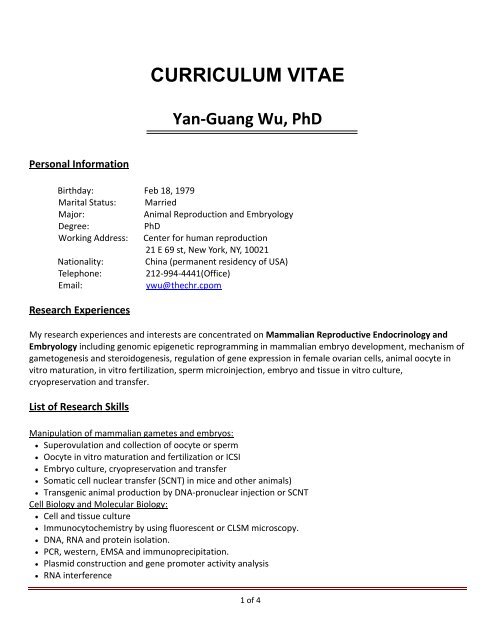

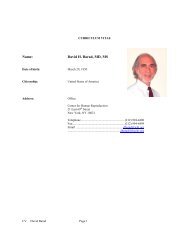
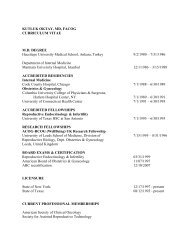
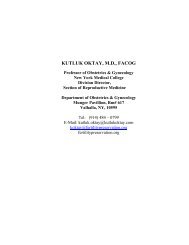

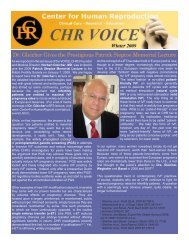
![Download Dr. Kushnir's Curriculum Vitae [PDF] - Center for Human ...](https://img.yumpu.com/31716705/1/190x245/download-dr-kushnirs-curriculum-vitae-pdf-center-for-human-.jpg?quality=85)
